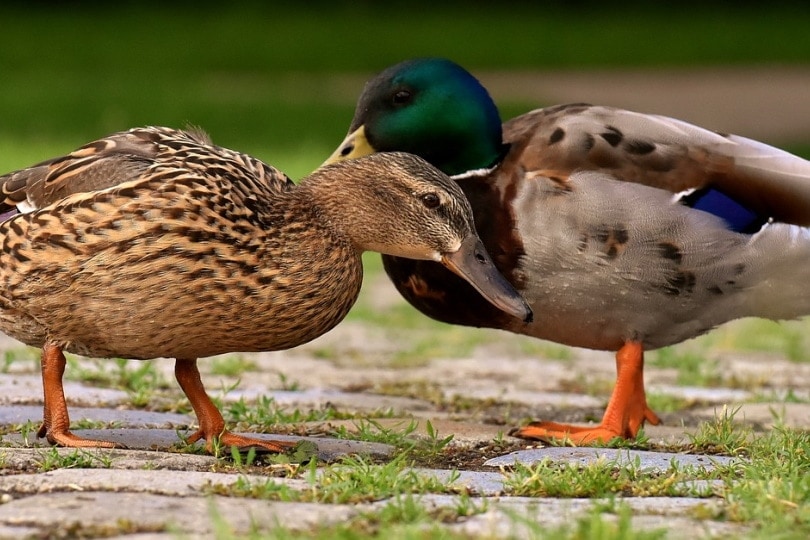Do Ducks Mate for Life? Are They Monogamous?
Last Updated on

It’s no secret that some birds mate for life. In fact, it’s quite common in many species. Even those birds that are genetically promiscuous can sometimes be socially monogamous—which means they have the same mate but sometimes also mate outside of the pair.
Others form relationships based on seasonal monogamy, where birds stay together for an entire breeding season to mate and care for their young. However, they will have a new partner the year after that. So, when it comes to ducks—what category do they fall under? Typically, they are seasonal monogamists—but not always. Let’s dig into the details of duck love.

How Waterfowl Pair Up
Monogamy is where a male and female pair for life, which is the way of life for 90% of bird species. While common, waterfowl are a bit different. Approximately 44% of all waterfowl mate for life, but interestingly, ducks are not included in that percentage.
Geese and swans have a high rate of mating for life, where you don’t see one without the other. Ducks, on the other hand, switch mates and only unite during mating season for reproduction purposes.
Geese do not start laying eggs until their second year, and swans don’t begin until their fourth year. When they finally pair up, males play a crucial role in the care and development of the eggs and raising their young.
If one of the pair dies, the other will eventually re-pair with another bird. However, they typically will spend a season alone without breeding at all. Also, divorce is a rare but noted happening waterfowl behavior resulting from unsuccessful nesting or hatching.

Ducks Are Seasonal or Polyamorous Breeders
No species of ducks are considered monogamous, but they can be momentarily. To ensure the survival of their species, males and females must work together to have successful offspring, no matter what breeding category they fall under.
Seasonal Breeders
Seasonal breeding is the leading way that ducks breed with one another, which often serves as a great survival technique. Even though these mated pairs are only together for a single season, their union provides a safe zone to hatch and raise young into successful juveniles who can care for themselves.
- Mallard ducks
- Teal ducks
- Canvasback ducks
- Redhead ducks

Polyamorous Breeders
Polygamy can occur in roughly 7% of duck species. This happens when there is no set mated pair, and multiple partners can occur over the breeding season.
- Ruddy ducks
- Musk ducks
- Comb ducks
- Maccoa ducks
A male usually shows dramatic displays of courtship and defending territory when this happens, which attracts multiple females. The males will, in turn, breed with those females and reproduce with as many as possible.
This is rare in most breeds. And even in polyamorous ducks, occasional bonds and seasonal breeding sometimes happens—though it is not commonplace.
Recurring Seasonal Monogamy in Ducks
Something interesting to consider with ducks and breeding is that a seasonal pair can meet up again in some instances. Some duck species go back to the exact place for breeding annually. When they do, it is possible, and even likely, for a previously mated pair to reunite.
- Bufflehead ducks
- Long-tailed ducks
- Harlequin ducks
- Common eider ducks
This is called philopatry behavior, when waterfowl return to the exact same site for breeding and wintering purposes.

What Determines Duck Breeding Style
Though researchers are still looking at all of the various breeding styles between species, there are several theories as to what determines breeding style.
Larger birds with a lower mortality rate seem to have life-long bonds—like geese and swans. These birds have fewer natural predators and produce fewer eggs than smaller waterfowl.
Because of the lack of need for constant breeding to ensure the species’ survival, monogamous bonds serve the pair best.
Ducks, on the other hand, are smaller birds with higher egg production. They are vulnerable to many more predators than larger waterfowl. To ensure the species thrives, having multiple partners, whether seasonal or polyamorous, increases the likelihood of offspring.
Related Read: Do Ducks Migrate? Where Do They Go?

In Conclusion
Unlike geese and swans, ducks are not monogamous creatures. However, they do display bonding and recurring breeding in some instances. To ensure that their species thrives, mating occurs seasonally—with some ducks displaying polygamy.
While details aren’t entirely definitive on breeding among waterfowl, mating for life happens more often in larger birds—like swans and geese.
You might also be interested in: Where Do Ducks Sleep?
Featured Image Credit: Alexas_Fotos, Pixabay
About the Author Ashley Bates
Ashley Bates is animal writer and enthusiast who is currently studying the art of animal therapy. A mother to four human children— and 23 furry and feathery kids, too – Ashley volunteers at local shelters, advocates for animal well-being, and rescues every creature she finds. Ashley's mission is to create awareness and education about animals of all shapes and sizes to promote proper care and respect.
Related Articles:
How to Clean a Refractor Telescope: Step-by-Step Guide
How to Clean a Telescope Eyepiece: Step-by-Step Guide
How to Clean a Rifle Scope: 8 Expert Tips
Monocular vs Telescope: Differences Explained (With Pictures)
What Is a Monocular Used For? 8 Common Functions
How to Clean a Telescope Mirror: 8 Expert Tips
Brightfield vs Phase Contrast Microscopy: The Differences Explained
SkyCamHD Drone Review: Pros, Cons, FAQ, & Verdict
